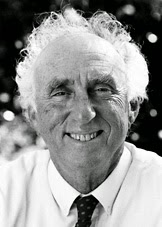
Martin Lewis Perl (1927-2014) photo: nobelprize.org
On June 24, 1927, American physicist and Nobel Laureate Martin Lewis Perl was born. He is best known for his discovery of the tau lepton, a subatomic massive particle with a negative charge. The tau, which he found in the mid-1970s, was the first evidence of a third “generation” of fundamental particles.
Tau Lepton
The tau lepton (τ, also called the tau particle, tauon or simply tau) is an elementary particle similar to the electron, with negative electric charge and a spin of 1/2, but with 3477 times the mass. Together with the electron, the muon, and the three neutrinos, it is classified as a lepton. Two main classes of leptons exist: charged leptons (also known as the electron-like leptons), and neutral leptons (better known as neutrinos). Charged leptons can combine with other particles to form various composite particles such as atoms and positronium, while neutrinos rarely interact with anything, and are consequently rarely observed. Tau leptons have a very short lifetime of 2.9×10?13 s and a mass of 1776.82 MeV/c2 (compared to 105.7 MeV/c2 for muons and 0.511 MeV/c2 for electrons). Since their interactions are very similar to those of the electron, a tau can be thought of as a much heavier version of the electron. Because of their greater mass, tau particles do not emit as much bremsstrahlung radiation as electrons; consequently they are potentially highly penetrating, much more so than electrons. However, because of their short lifetime, the range of the tau is mainly set by their decay length, which is too small for bremsstrahlung to be noticeable: their penetrating power appears only at ultra high energy.
Martin Perl
Let’s take a look on the discovery of the Tau and the man who succeeded to find it. Martin Perl was born on June 24, 1927 in New York City, New York to a family of Jewish emigrants to the US from the Polish area of Russia. Perl is a 1948 chemical engineering graduate of Brooklyn Polytechnic Institute. After graduation, he worked for the General Electric Company, as a chemical engineer in a factory producing electron vacuum tubes. To learn about how the electron tubes worked, Perl signed up for courses in atomic physics and advanced calculus at Union College in Schenectady, New York, which led to his growing interest in physics, and eventually to becoming a graduate student in physics in 1950.
Martin Perl received his Ph.D. from Columbia University in 1955, where his thesis described measurements of the nuclear quadrupole moment of sodium, using the atomic beam resonance method that his advisor Isaac I. Rabi had won the Nobel Prize in Phyics for in 1944.[4] Perl spent 8 years at the University of Michigan, where he worked on the physics of strong interactions, using bubble chambers and spark chambers to study the scattering of pions and later neutrons on protons. Seeking a simpler interaction mechanism to study, Perl started to consider electron and muon interactions. He had the opportunity to start planning experimental work in this area when he moved in 1963 to the Stanford Linear Accelerator Center (SLAC), then being built in California. He was particularly interested in understanding the muon: why it should interact almost exactly like the electron but be 206.8 times heavier, and why it should decay through the route that it does. Perl chose to look for answers to these questions in experiments on high-energy charged leptons. In addition, he considered the possibility of finding a third generation of lepton through electron-positron collisions.
Triton
The tau was finally detected in a series of experiments between 1974 and 1977 by Perl with his colleagues at the SLAC-LBL group. They were able to collide electrons and positrons at higher energies than had previously been possible, initially at up to 4.8 GeV and eventually at 8 GeV, energies high enough to lead to the production of a tau/antitau pair. Because of the very short lifetime of the tau, these particles decayed within a few millimetres of the collision. Hence Perl and his coworkers did not detect the tau directly, but rather discovered anomalous events where they detected either an electron and a muon, or a positron and an antimuon. The symbol τ that was chosen for tau was derived from the Greek “triton”, meaning “third” in English, since it was the third charged lepton discovered. Martin Perl won the Nobel Prize in 1995 jointly with Frederick Reines. The prize was awarded “for pioneering experimental contributions to lepton physics“. Perl received half “for the discovery of the tau lepton” while Reines received his share “for the detection of the neutrino“[3]
Martin Perl died after a heart attack on September 30, 2014 at the age of 87.
Martin Perl, Tomorrow 2009, [6]
References and Further Reading:
- [1] Martin Perl biography at Nobelprize.org
- [2] Press Release for the 1995 Nobel Prizes in Physics
- [3] Frederick Reines’ Chase for the Ghost Particle, SciHi Blog
- [4] Isidor Isaac Rabi and the Nuclear Magnetic Resonance, SciHi Blog
- [5] Martin Perl at Wikidata
- [6] Martin Perl, Tomorrow 2009, PresidentialConf @ youtube
- [7] Martin L. Perl (1995). “Reflections on the Discovery of the Tau Lepton”
- [8] Overbye, Dennis (3 October 2014). “Martin Perl, 87, Dies; Nobel Laureate Discovered Subatomic Particle”. The New York Times.
- [9] Martin Perl Timeline via Wikidata





